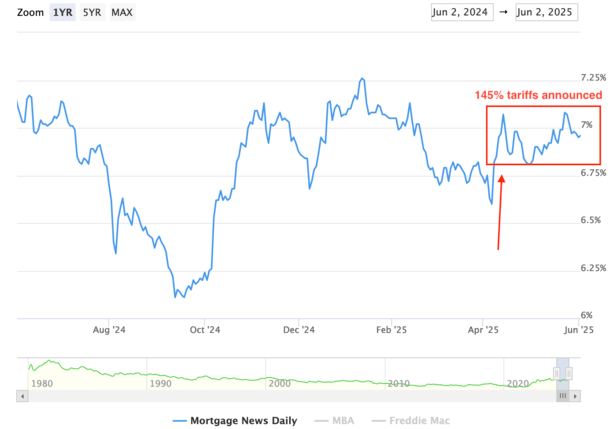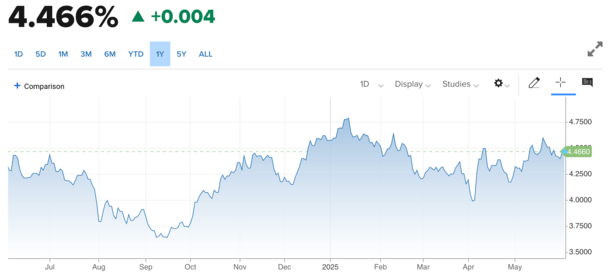Lately, the best single word to sum up mortgage rates has been “stuck.”
Ever since early April when they jumped higher as the trade war escalated, they’ve basically gone nowhere fast.
Sure, they ebb and flow every day, similar to the stock market, but they’ve been in very tight range.
Basically hovering between 6.875% and 7.125%, or just one quarter of one percent, but at a crucial time during the home buying season.
If you’re looking for rate relief, like the tariff situation, you might just need to be patient.
Is the TACO Trade Keeping Mortgage Rates Higher for Longer?

In case you haven’t heard, there’s a new acronym known as TACO, or Trump Always Chickens Out.
Simply put, it refers to the President’s waffling (sorry for a different food analogy) on the tariffs, but often capitulating when there’s any whiff of a bad day on the stock market.
One day, he wakes up and says the tariffs are on. The next day, they’re off. Then they’re back on again.
This has also led to Karate Kid memes that say Tariff on, Tariff off.
The stock market seems to cheer this, but bonds seem a little less enthused, and mortgage rates might be suffering as a result.
Just check out the MND chart above, which shows mortgage rates jumped in early April when tariffs ratcheted up, and have been stuck higher ever since.
My theory is that the longer this back-and-forth goes on, the longer it will take for anything to change.
As such, the Federal Reserve won’t be able to lower its own interest rate, even though Trump himself and FHFA director Pulte have explicitly asked chair Powell to do so.
Call it ironic, but you can’t create massive levels of uncertainty while also asking for more accommodative monetary policy.
This isn’t political, it’s just common sense. The Fed needs clarity to make any interest rate decisions, otherwise they’ll just stand pat.
Funnily enough, if there wasn’t a trade war, we’d probably be seeing the Fed’s first rate cut (since last year) in a couple weeks.
Instead, the Fed is taking a wait-and-see approach and even said as much in its last FOMC statement, as “the risks of higher unemployment and higher inflation have risen.”
At the same time, bond traders are also taking a cautious approach, meaning the bond yields that dictate long-term mortgages rates are also staying stubbornly high.
The Promise of Lower Mortgage Rates Keep Getting Pushed Further Out
Many expected the 30-year fixed to begin improving in the second half of 2025, including myself.
In fact, I predicted that mortgage rates would start with a 5 by the fourth quarter of this year.
It’s still possible, but with all the trade drama, it just feels like those forecasts are being pushed further and further out.
The same basic outlook exists, it’s just that we can’t get there until we get clarity on the trade situation.
In other words, it’s like having a set destination, but stopping multiple times or taking whatever is the opposite of a shortcut for no apparent reason.
Most don’t expect the tariffs to bear any major fruit, or even stick at this point, so it’s really just a sideshow that’s delaying the inevitable.
That inevitable is a cooling economy, rising unemployment, and likely lower bond yields (and mortgage rates).
It’s just that the timing keeps changing because we don’t know what to expect each day.
The funny thing is the stock market seems to cheer any semblance of good news on trade, whereas the bond market can’t catch a break either way.
If tariffs roll back, it’s bad for bonds. If tariffs ratchet up, it’s bad for bonds. And this all seems to be driven by uncertainty.
Remember, mortgage rates like bad economic news, but they don’t like not knowing where we’re headed.
Ever Heard of StagDeflation?

Most of us have heard of stagflation, which is slow or no growth mixed with higher prices and high unemployment.
But what about so-called “stagdeflation,” which is apparently slow growth, high unemployment, and lower prices?
Some believe the tariffs will have a one-time impact on inflation and shouldn’t be considered when determining monetary policy.
Along these same lines, there’s the thought that the economic data related to employment supersedes the tariffs anyway.
As stated, the trade war and tariffs are a sideshow, while the economic data that continues to take center stage is unemployment. Inflation is old news anyway, right?
Many still expect layoffs to rise as the year goes on, and if prices don’t, we could have a situation where bond yields come down and the Fed starts cutting again.
There remains a strong case for 10-year bond yields already being at the top of their range, around 4.50%, with the lower end around 3.75%.
If and when the economy shows signs that it’s cooling, perhaps as the trade stuff continues to fester, bond yields might make their way lower regardless.
Assuming a 3.75% yield and a spread of around 225 basis points (bps), we could see a 30-year fixed right around 6%.
That would certainly lead to a lot more rate and term refinance applications, but it’s unclear if home buyers would bite.
After all, they still need to be gainfully employed and optimistic about the future to move forward with a home purchase.
Read on: Mortgage rates are still expected to come down by the end of 2025.
(photo: lorenz.markus97)

